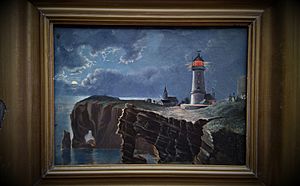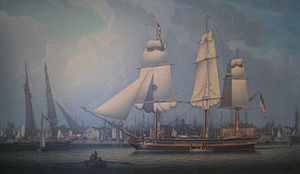Robert Salmon facts for kids
Quick facts for kids
Robert Salmon
|
|
|---|---|

The East Indiaman "Warley", 1804. National Maritime Museum, Greenwich, England
|
|
| Born |
Robert Salomon
1775 Whitehaven, Cumberland, England
|
| Died | 1845 (aged 70+) Cumberland, after 1845 (exact date uncertain)
|
| Nationality | British |
| Known for | Maritime art, Seascapes |
|
Notable work
|
Picture of "The Dream" Pleasure Yacht, View of Venice |
| Movement | Luminism |
Robert Salmon (born in 1775, died around 1845) was a famous artist. He painted mostly pictures of the sea and ships. He worked in both England and America. Salmon painted almost 1,000 pictures, and nearly all of them were about the sea. Many people see him as the "Father of American Luminism". This was a style of painting that focused on light.
Contents
Robert Salmon's Early Life in England
Robert Salmon was born in Whitehaven, England. This happened in October or November of 1775. His birth name was Robert Salomon. He was christened on November 5, 1775. His father, Francis Salomon, was a jeweler.
Young Robert Salmon studied the works of other famous painters. He looked at Dutch marine painters from the 1600s. He also studied Italian painters who made detailed city views. He learned from Claude Lorrain, a French artist known for landscapes. We don't know much else about his early art training.
His first known paintings are from 1800. They are called Two Armed Merchantmen Leaving Whitehaven Harbor and The ‘Estridge’ Off Dover. He showed his first painting at the Royal Academy in 1802.
In 1806, Robert Salmon moved to Liverpool, a busy port city. This is when he changed his name from Salomon to Salmon. Many of his sea paintings from this time still exist today. You can see them in the National Maritime Museum in London. His paintings of ships show he knew a lot about how sailing ships worked. He often painted the same ship from two different angles in one picture.
He moved around a lot during these years. In 1811, he went to Greenock, Scotland. Then he came back to Liverpool in 1822. He returned to Greenock in 1826. After that, he moved to London in 1827. He also lived in Southampton, North Shields, and Liverpool again.
Like many young artists, Salmon thought he could find more success in the United States. Before he left in 1828, he painted a portrait. It was his only known portrait of a person. The painting was of a famous sailor, John Paul Jones. Salmon hoped this painting would connect him with people in his new home. He didn't know that people in America had mostly forgotten about John Paul Jones by then.
Moving to America and Life in Boston
In 1828, Salmon sailed from Europe to the United States. He arrived on New Year's Day in 1829. He lived in Boston until 1840. He lived in a small hut on Marine Railway Wharf. This spot gave him a great view of Boston Harbor.
Salmon became very successful painting marine scenes in Boston. He got many requests to paint pictures of ships. Boston Harbor grew a lot in the early 1800s. Salmon painted between 300 and 400 pictures of the harbor. He painted in a style similar to Dutch painters from the 1600s. People thought he was a bit unusual. They described him as a quiet and sometimes grumpy person.
Salmon quickly became one of the most important seascape painters in Boston. He spent his time painting and working in a printing studio. There, he met other artists like William Bradford and Fitz Henry Lane. Salmon's meeting with Fitz Henry Lane was very important. You can see Salmon's influence in Lane's later sea paintings.
During his life, Salmon's art was very popular. Wealthy people in Boston bought his paintings. These collectors included Samuel Cabot, Robert Bennett Forbes, and John Newmarch Cushing.
Later Years and Legacy
Salmon left Boston in 1842. For many years, people thought he had died soon after leaving. But he actually went back to Europe. He traveled to Italy. Several paintings of Italian scenes are believed to be by him. The latest one is from 1845. This is the last year we have any record of his work. We don't know the exact date he died.
Robert Salmon's paintings are in many museums today. You can find them at the U.S. Naval Academy. They are also at the Museum of Fine Arts, Boston. Other places include the National Maritime Museum in England. The Walker Art Gallery in Liverpool also has his work. You can see his art at the New Britain Museum of American Art in Connecticut. The Yale Center for British Art has some too. The Mariners' Museum in Virginia and the Peabody Essex Museum in Salem also display his paintings.
Gallery








